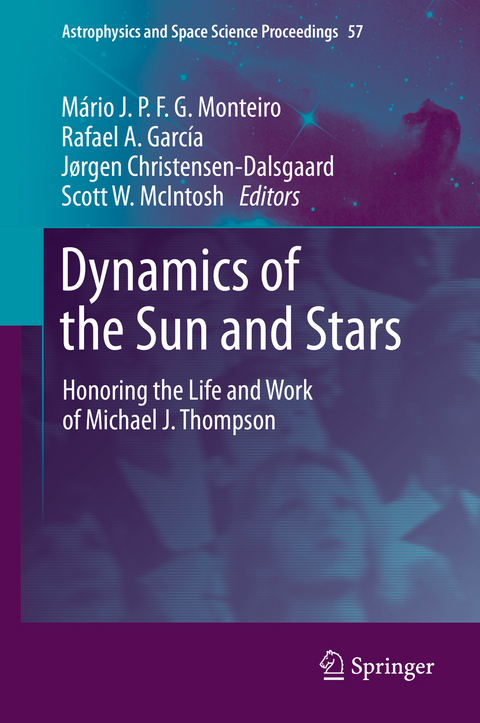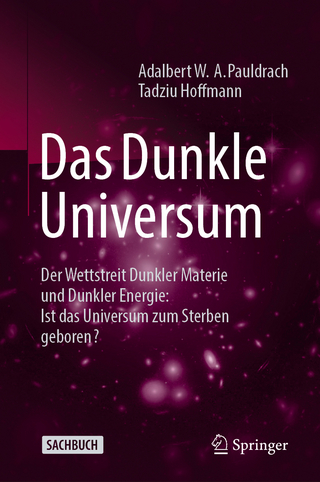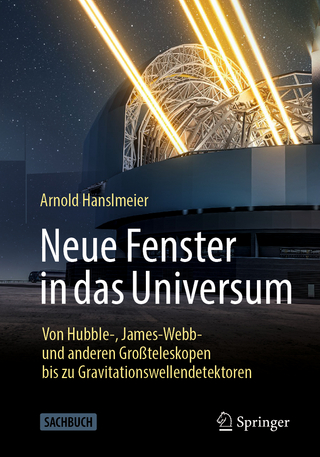
Dynamics of the Sun and Stars
Springer International Publishing (Verlag)
978-3-030-55335-7 (ISBN)
These are the proceedings of a meeting celebrating Michael Thompson's seminal work on solar and stellar physics, as well as his major contributions to the development of the National Center for Atmospheric Research. The meeting also marked Michael J. Thompson's untimely death in October 2018. Michael played a key role in the development of helioseismology and its application to the study of the structure and dynamics of the solar interior, and he provided a strong foundation for the extension of seismic studies for other stars. After focusing for several years on more administrative activities, he was returning to leading the seismic studies of solar interior rotation and he was deeply involved in the understanding of the dynamics of the core of stars, when his life was tragically lost.
The conference focused on dynamical aspects of the sun and stars, based on the large amount of data available on solar and stellar oscillations, and the extensive and detailed modelling now becoming feasible. Combining observations, seismic analysis, and modelling the meeting and this book serve as a fitting memorial to a close colleague and friend, much missed.
Mário Monteiro completed his PhD in 1996, at Queen Mary University of London, under the supervision of Prof. Michael J. Thompson. He is an Associated Professor in the University of Porto and Director of the Department of Physics and Astronomy of the Faculty of Sciences U.Porto. He is also a senior researcher at the Institute of Astrophysics and Space Sciences - U.Porto, where he leads the team on Stellar Astrophysics, and is the National Delegate to the ESA's Science Program Committee. He coordinates the national Doctoral Network for Space Sciences (PhD::SPACE). Main research interests include the development of seismic probes of stellar physics, namely energy transport and transport processes, as well as testing the modelling and seismic characterization of stars at different evolutionary stages and of different properties (with special focus on main sequence solar-like stars). He has participated in several space missions for asteroseismology (CoRoT/CNES&ESA, Kepler/NASA, TESS/NASA), being also involved in the preparation of future space missions Rafael A. García completed his PhD in 1996 at the University of La Laguna (Tenerife, Spain), under the supervision of prof. Teodoro Roca Cortés and prof. Clara Régulo Rodriguez. He is a senior research scientist at the Astrophysics Division of the CEA Saclay in France where he leads the solar and stellar seismology team. He is member of the scientific council of the "Physics of the two infinities and their origins (P2IO)" Excellence Laboratory (Labex) of the Paris-Saclay University. He is the responsible at CEA of the ESA M3 PLATO space mission activities and of the GOLF instrument on board SoHO. Main research interests include the study of internal and surface solar and stellar rotation, magnetic fields and magnetic cycles, in particular for main sequence solar-like stars and red giants. He is an expert of seismic data analysis as well as to use seismic tools to probe stellar interiors providing strong constraints for solar and stellar modelling. He has participated in the development and/or exploitation of several space missions for helioseismology (SoHO/ESA & NASA) and for asteroseismology (CoRoT/CNES&ESA, Kepler & K2/NASA and TESS/NASA) as well as in the development of future space missions (PLATO/ESA). Jørgen Christensen-Dalsgaard completed his PhD in 1978, at the Department of Applied Mathematics and Theoretical Physics, Cambridge (UK), under the supervision of Prof. Douglas Gough, who also supervised Michael Thompson's PhD studies. He is professor of astrophysics at Aarhus University, Denmark, and head of the Stellar Astrophysics Centre. In addition, he leads the Kepler and TESS Asteroseismic Consortia, and the Stellar Oscillations Network Group, aiming to establish a global network of modest-sized telescopes for asteroseismology. He has been President of Division V of the International Astronomical Union and Danish delegate, and for one year chair, of ESA's Science Programme Committee. Main research interests include helio- and asteroseismology, in particular precise modelling of stellar evolution and stellar oscillations, and the development and use of techniques for helio- and asteroseismic analyses. This includes computation of the so-called solar Model S, which has become a de facto reference in helioseismic investigations. He has contributed to the asteroseismic utilization of data from Kepler and TESS, including characterization of stars hosting exoplanetary systems. He has been strongly involved in helioseismic observing facilities, including as Co-Investigator on instruments on the SOHO spacecraft, and he is Co-Investigator on the NASA Kepler and TESS missions. He leads a work package under the PLATO Science Management effort dealing with the final characterization of stars. Scott McIntosh is the Deputy Director of National Center for Atmospheric Research (NCAR) and was Director of
Part I: The Life and Work of Michael J. Thompson.- Michael Thompson's Legacy in Solar and Stellar Physics.- Michael Thompson in Sheffield.- Michael J. Thompson: A Remarkable Scientist, Leader, and Friend.- Michael.- Assessing the Threat of Major Outbreaks of Vector-Borne Diseases Under a Changing Climate.- Touching the Interior Structure and Dynamics of Our Nearest Star.- Part II: Solar Interior and Dynamics.- Uncovering the Hidden Layers of the Sun.- Solar Rotation.- On Solar and Solar-Like Stars Convection, Rotation and Magnetism.- Recent Progress in Local Helioseismology.- Time-Distance Helioseismology of Deep Meridional Circulation.- Surface Rotation and Magnetic Activity of Solar-Like Stars: Impact on Seismic Detections.- Study of Acoustic Halos in NOAA Active Region 12683.- Helioseismic Center-to-Limb Effect and Measured Travel-Time Asymmetries Around Sunspots.- Probing the Variation with Depth of the Solar Meridional Circulation Using Legendre Function Decomposition.- New Inversion Scheme for Time-Distance Helioseismology.- On Active Region Emergence Precursors.- Solar Hemispheric Helicity Rules: A New Explanation.- Comparing Solar Activity Minima Using Acoustic Oscillation Frequencies.- Solar Cycle Variation of Large Scale Plasma Flows.- Measuring the Dispersion Relation of Acoustic-Gravity Waves in the Solar Atmosphere.- Non-adiabatic Helioseismology via 3D Convection Simulations.- Part III: From the Sun to the Stars.- Deciphering Solar Convection.- G Modes and the Solar Core.- Inverse Analysis of Asteroseismic Data: A Review.- Diagnostics from Solar and Stellar Glitches.- Dynamo States with Strikingly Different Symmetries Coexisting in Global Solar Simulations.- Influence of Turbulence on an Essentially Nonlinear Dynamo Mechanism.- Part IV: Stellar Dynamics.- The Tachocline Revisited.- Seismic Signatures of Solar and Stellar Magnetic Activity.- Confinement of Magnetic Fields Below the Solar Convection Zone.- Asteroseismic Study of KIC 11145123: Its Structure and Rotation.- The Impact of a Fossil Magnetic Field on Dipolar Mixed-Mode Frequencies in Sub- and Red-Giant Stars.- Asteroseismic Stellar Modelling: Systematics from the Treatment of the Initial Helium Abundance.- Direct Travel Time of X-ray Class Solar Storms.- On the Limits of Seismic Inversions for Radial Differential Rotation of Solar-Type Stars.- The Physical Origin of the Luminosity Maximum of the RGB-Bump.- A New Utility to Study Strong Chemical Gradients in Stellar Interiors.- 16 Cygni A: A Testbed for Stellar Core Physics.- Exploring the Origins of Intense Magnetism in Early M-Dwarf Stars.- Part V: The Future.- A Future Path for Solar Synoptic Ground-Based Observations.- Observational Asteroseismology of Solar-Like Oscillators in the 2020s and Beyond.- Oblique Pulsation: New, Challenging Observations with TESS Data.- Accounting for Asphericity.- A Comparison of Global Helioseismic-Instrument Performances: Solar-SONG, GOLF and VIRGO.- Open Discussion.- Contemplating the Future.
"The articles in these proceedings range from review papers that give the reader a great exposure to the intricacies of the subjects covered ... to recent results of work in progress, allowing the reader to get a good sense of where the field stands. The proceedings include contributions from both oral and poster presentations. The quality of the articles is a great tribute to the legacy of Mike's work and his impact on the field." (Sylvain Korzennik, The Observatory, Vol. 142 (1289), August, 2022)
“The articles in these proceedings range from review papers that give the reader a great exposure to the intricacies of the subjects covered … to recent results of work in progress, allowing the reader to get a good sense of where the field stands. The proceedings include contributions from both oral and poster presentations. The quality of the articles is a great tribute to the legacy of Mike’s work and his impact on the field.” (Sylvain Korzennik, The Observatory, Vol. 142 (1289), August, 2022)
| Erscheinungsdatum | 23.12.2020 |
|---|---|
| Reihe/Serie | Astrophysics and Space Science Proceedings |
| Zusatzinfo | XIV, 343 p. 110 illus., 23 illus. in color. |
| Verlagsort | Cham |
| Sprache | englisch |
| Maße | 155 x 235 mm |
| Gewicht | 705 g |
| Themenwelt | Naturwissenschaften ► Physik / Astronomie ► Astronomie / Astrophysik |
| Schlagworte | Magnetic Fields in Stars • Measuring solar oscillations - Helioseismology • Measuring stellar oscillations - Asteroseismology • Michael J. Thompson • Stellar and Solar Physics |
| ISBN-10 | 3-030-55335-3 / 3030553353 |
| ISBN-13 | 978-3-030-55335-7 / 9783030553357 |
| Zustand | Neuware |
| Informationen gemäß Produktsicherheitsverordnung (GPSR) | |
| Haben Sie eine Frage zum Produkt? |
aus dem Bereich


